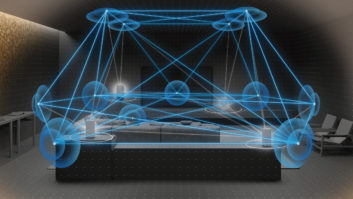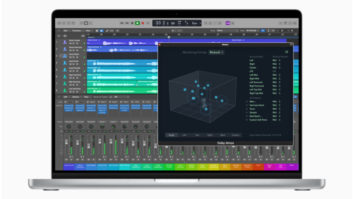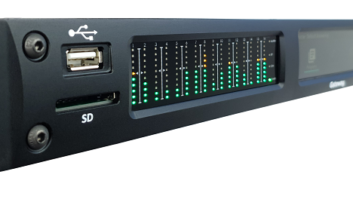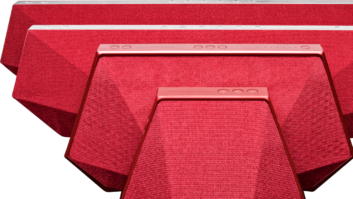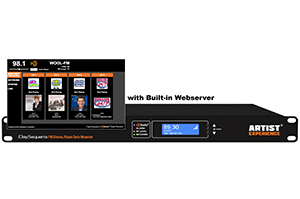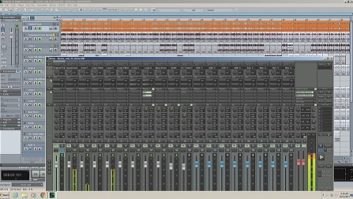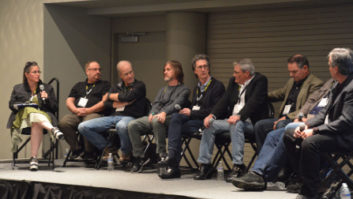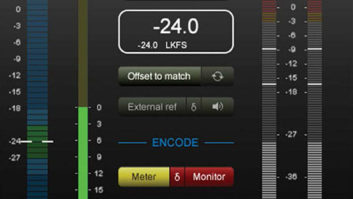Hot debate over new service for radio promises to enliven weekend session.
* Sunday morning, April 17: “Surround Sound – A New Frontier for Radio”
* Sunday afternoon, April 17: “HD Radio Technology”
Few topics have burned up the pages of Radio World in recent months as much as surround sound. That’s also the focus at NAB2005 of a Sunday morning series of Broadcast Engineering Conference presentations.
An afternoon session looks at HD Radio issues. Here’s a rundown of radio engineering-related sessions on Sunday April 17.
All around you
“Surround Sound – A New Frontier for Radio” is to be chaired by Milford Smith, vice president of engineering for Greater Media and winner of this year’s NAB Radio Engineering Achievement Award.
Surround has already shown up in real-world HD Radio situations. But what is involved in implementing surround for a typical broadcast station, and is it worth it?
“There is a lot of buzz going around that surround sound might just be the ‘killer app’ for HD Radio,” Smith told us. “I’m not ready to make that prediction quite yet, but I do think it is a very attractive technology to both listeners and receiver manufacturers and has the potential of being implemented at a relatively rapid rate because of that attractiveness.”
He continued, “I think the real implementation hurdle is the number of currently incompatible systems. At the moment, it would be a bit difficult to decide on which one to implement with any certainty that it would be ‘the’ system or at least the dominant system. System architectures also vary, some are completely matrixed based within the two stereo channels … others have supplementary steering information that needs to be transmitted,” Smith said.
“I am glad to see the NRSC DAB subcommittee start up a surround sound working group to take a look at these systems, collect the relevant information and better inform all of us as to their capabilities.”
Frank Foti, president of Omnia Audio, is one who thinks surround sound may be the “killer app.”
He leads off the morning with his paper, “The Killer App for FM: Distinct 5.1 Surround Sound.” His presentation introduces a spatial audio coding system developed by the Fraunhofer Institute that takes advantage of current research in aural perception.
The system is the only one so far to provide a distinct multi-channel listening experience to the FM radio audience, he says.
“HD Radio needs a ‘wow’ factor for the FM IBOC system, and 5.1 surround is it,” he said. “Of importance, though, is that our industry chooses the best system for this technology. This session will reveal the strengths and weaknesses of the various surround methods.”
“HDC Surround, 5.1 Surround Over HD Radio” is the title of a paper written by Jonas Röden, Senior Research Engineer for Coding Technologies Sweden.
David Frerichs, vice president and U.S. general manager of Coding Technologies, will present the paper and explain the technical basics of the 5.1 surround system developed by his company and Philips.
He will show how a high level of quality can be achieved and explain how HDC Surround fits into the bigger picture of radio.
“Digital radio should not be limited to an analog solution for surround sound,” he said. “HDC Surround is a fully scalable, digital system built by Coding Technologies, the brains behind the current HDC codec used in HD Radio. With HDC Surround, broadcasters can go from minimal steering to full steering, maximizing the quality according to the available bandwidth.
“Analog matrix and watermark solutions just cannot reach the ‘data rate’ required to provide a satisfactory surround experience. Instead of saddling a new radio system with old, limited technology, we should embrace a fully digital, scalable technology for digital radio,” he said.
“5.1 & 2.0 Interspersion: A Reality” is to presented by Robert Reams, CTO, co-founder and chief scientist for Neural Audio Corp.
Reams will discuss the interspersion of legacy 2.0 and 5.1 content and says failure to deal with this on a system basis will result in transition problems. He will present Neural’s spatial compression and rendering methodology, which allows the distributor or broadcaster the ability to capture original source 5.1 content and “downmix” it to a 2.0 channel format while giving consumers the option to render the content in any spatial format they choose.
“Widespread acceptance of 5.1 radio broadcasting isn’t as far away as once thought,” he said. “2.0 and 5.1 content interoperability doesn’t have to be scary, expensive or dangerous. Modern digital signal processing can modernize the ‘workhorse’ content distribution infrastructure every bit as effectively as replacing it. The key is planned, staged transitioning from where the broadcaster is now to where the broadcaster wants to be at a rate of adoption that makes tactical and fiscal sense.”
Shigeru Aoki, R&D engineer for the Japan FM Network, is scheduled to present “The Surround Sound Program for Radio.” Aoki plans to discuss his experiences with putting 5.1 surround on the air on his network in both digital and analog services and show how 5.1 can be encoded onto analog FM stations. Note that at press time, this speaker said his attendance in Las Vegas was uncertain.
Digital in the real world
“HD Radio Technology” will be the topic for the afternoon radio engineering session, chaired by Norm Phillips, technical operations manager for Susquehanna Corp. in Dallas, and Chriss Scherer, editor of Radio magazine.
Phillips is a strong supporter of HD Radio and thus a natural choice as chair.
“The audio improvement of a well-done FM HD Radio station is a total lack of multipath-induced noise,” he said. “The installation of HD transmitters can be very simple or extremely complicated, depending on the amount of knowledge and planning an engineer begins with.
“This session will not only present some new technology but will have over an hour of HD Radio installation case studies from five markets. Low-level, high-level, combined antenna, split-level, electrical needs, HVAC and other issues will be covered.”
Addressing HD Radio STL issues is Sunil Naik, engineering director of Moseley Associates. In “Hitless Space Diversity STL Enables IP and Audio in Narrow STL Bands,” Naik will discuss means of transmitting a 300 kbps IP channel alongside a 44 kHz stereo pair within a 300 kHz STL channel. He will present a new transfer panel that allows “hitless” switching for real-time implementation of space-diversity antenna systems for 128 QAM.
“Linearizing HD Radio Transmitters – A Technology Survey” will be presented by Anders Mattsson, principal engineer at Harris Broadcast Communications. Mattsson will cover advanced equalization techniques, including Volterra-based and Neural-based equalizers.
In addition, the differences between baseband and RF pre-distortion and their respective advantages and disadvantages will be discussed.
Henry Downs, associate principal electrical engineer of custom RF products for Dielectric Communications, will present “IBOC Considerations for Multichannel FM Installations.”
Downs plans to discuss the combining of multiple analog and digital signals into a common antenna, with an emphasis on site-specific solutions.
“The key to successful HD Radio implementation is the minimization of the losses incurred when the existing analog signal is combined with the new digital sidebands,” he said.
“In the case of a multi-transmitter site with a master antenna, the least lossy solution offered is to effect combination of the analog and digital portions of the signal in the antenna itself.”
“Split Level Combining Explained” will be presented by Steve Fluker, director of engineering for Cox Radio in Orlando.
“In order to understand this technology, it’s important to have a good understanding of just what HD Radio is, how it works and what combining is.” He plans to explain “how the analog and digital signals are basically two separate radio stations and the challenge is how to transmit both carriers at the same time.”
Jerry Westberg, senior design engineer for Broadcast Electronics, will talk about his paper, “4M Modulation and Its Benefits on Digital Radio.”
Westberg will discuss limitations of PWM transmitters trying to pass an IBOC signal and how these limitations can be overcome by using a DSP-based 4M modulation scheme with no PWM filtering. The result is much higher quality in both the digital and analog domains, the company argues.
“HD Radio Installation – Two Case Studies” will be presented by Erick Steinberg, director of technical operations at Susquehanna Radio San Francisco. Last year, Susquehanna installed HD Radio systems at three of its Bay Area FM stations. Steinberg will discuss his experiences with the high-level system used for KFOG and the low-level system on KSAN.
Paul Shulins, director of technical operations for Greater Media in Boston, will discuss his HD Radio experiences in “HD Radio at Greater Media Boston.” Shulins will discuss his research and data collection techniques for measuring the coverage of the HD Radio signal, correlating it with the analog signal and local topography. He will discuss leveraging the investment in HD Radio transmitters to provide benefits to the analog systems already on the air.
“Improving Transmitter Linearity in FM HD Radio Using Digital Adaptive Pre-Correction” will be covered by Tim Hardy, head of development for Nautel Ltd. Hardy will cover the theory of pre-correction in general and will go into detail on the adaptive system.
“The advantage of adaptive pre-correction is in its ability to keep the emissions below the mask under changing conditions,” he said. The paper will include measured results that he says demonstrate that fixed pre-correction cannot guarantee compliance in certain real-world situations while the adaptive system is compliant in those same situations.
Derek Kumar, vice president of engineering for Digital Radio Express, will present, “A New Approach to Digital Radio Broadcasting in the FM Band.” In his paper, Kumar will introduce a new digital FM subcarrier technology promising an order of magnitude increase in data throughput and reliability.
“This is accomplished by using state-of-the-art digital modulation, error correction coding (turbo coding), equalization and audio compression (world standard aacPlus v2 technologies),” he wrote. Also on tap Sunday, in addition to the above sessions, Charles Morgan, the senior vice president of Susquehanna Radio Corp., will provide an update of activities at the NRSC in a morning talk.
In the afternoon, Don Messer, director of the Spectrum Management Division of International Broadcasting Bureau, speaks about “The DRM Digital Modulation System: Performance in the AM Band, Including Comparisons with Amplitude Modulation.”





